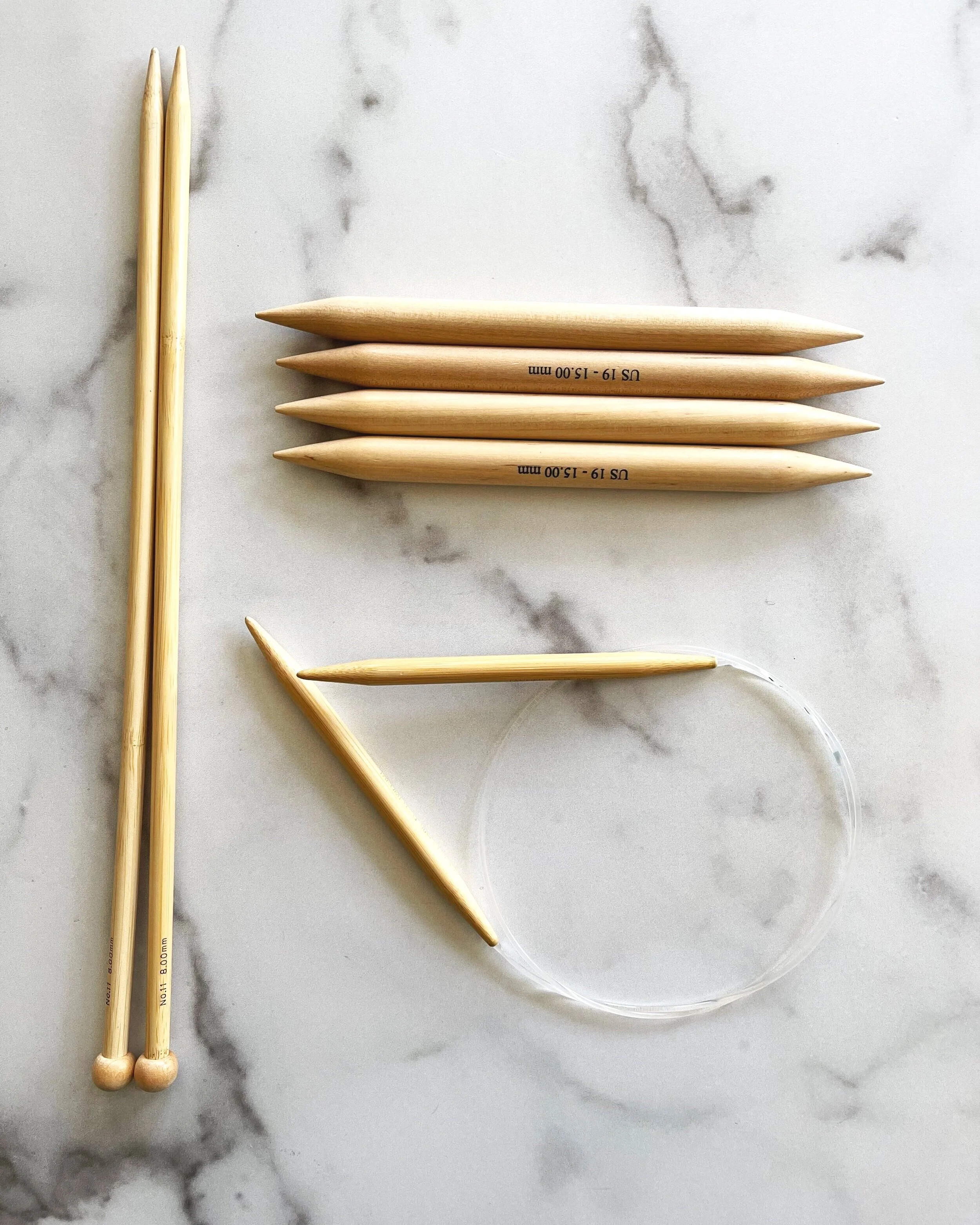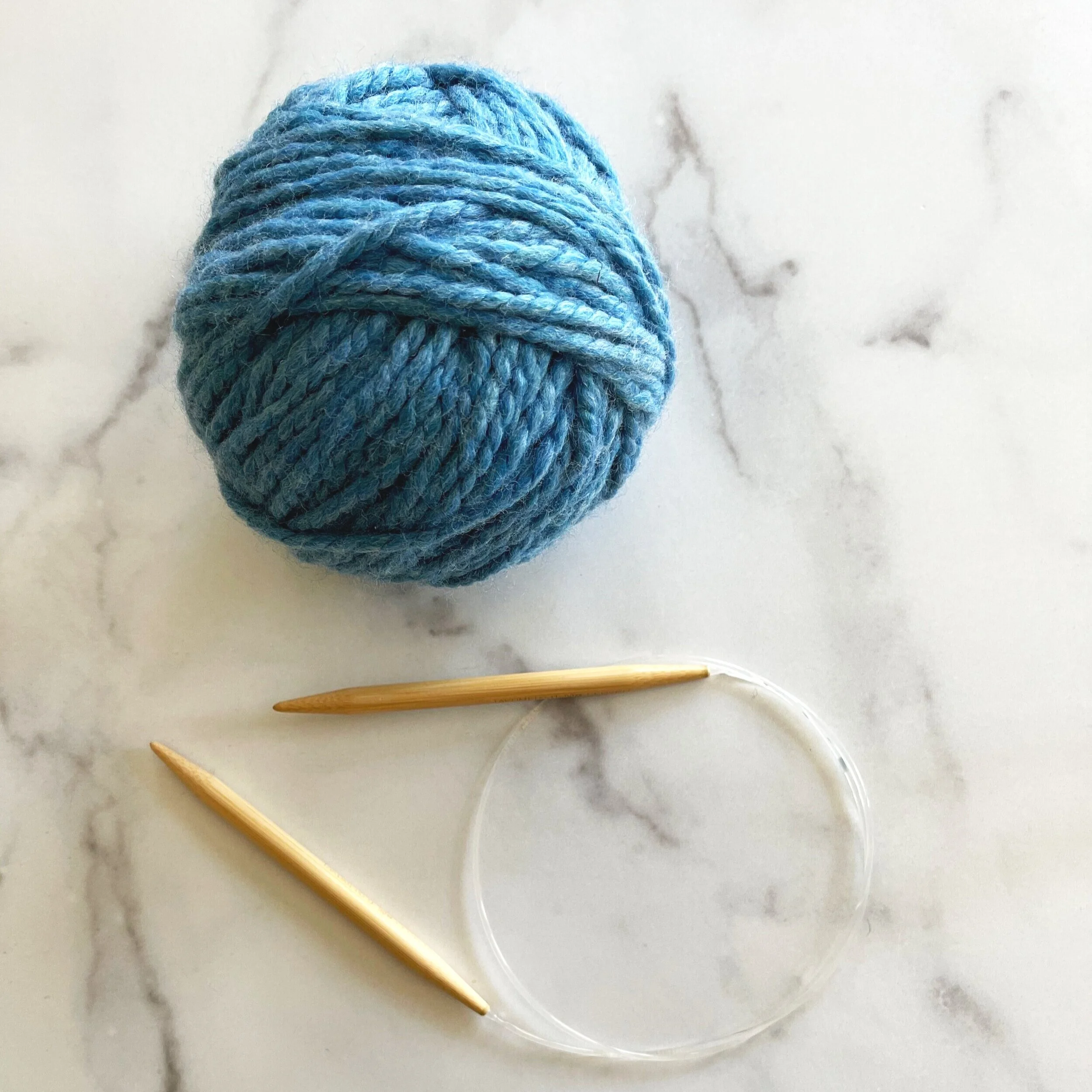The 3 Different Types of Knitting Needles | What Should You Use?
There are many different types of knitting needles out there and it’s great to have a general understanding of the three kinds of needles, especially if you’re a beginner knitter. While knitting patterns will note what kinds of needles you need to create a specific sweater, hat, scarf, cowl or any other project, it’s great to have an overall picture about the different kinds of knitting needles and their uses. In this post, I’m going to give you an overview of the 3 main types of knitting needles: straight, circular, and double pointed needles (DPNs). I’ll also give you an idea of the different kinds of projects to make with them and their pros and cons.
Straight
Knitting
Needles
The Different Types of Knitting Needles: Straight Needles
Straight needles are two separate needles with a point on one side and an endpoint on the other side to prevent stitches from slipping off the end. They come in the standard needle sizes all different and lengths. The wider your project, the longer the straight needles you’ll need so that all of your stitches fit comfortably on one needle. You start with all of the stitches on one needle and work across each stitch so that all of the stitches end up on the other needle when you’re finished knitting a row.
Typical Uses for Straight Needles
Straight needles are typically used for knitting flat, which means knitting across stitches on the right side of the work and then turning the work over and knitting across the wrong side.
Types of Projects for Straight Needles
Straight needles are typically used for accessories and garments knit flat like scarves as well as hats, cowls, and small sweaters or cardigans that are knit flat and then seamed together. This means that small pieces are knit separately and then joined together with a tapestry needle by hand sewing.
Pros of Straight Needles
Straight needles are great for beginner knitters as it can be easier to visually understand how to knit across the stitches from one needle to another. If you’re someone who likes knitting small pieces and then seaming everything together at the end, straight needles are for you.
Cons of Straight Needles
Straight needles can be difficult to work with, especially if they’re long. One needle can get heavy and it can be awkward to knit with if you have long and wide pieces. They have limited use since they can only be used for knitting pieces flat.
Double
Pointed
Needles
The Different Types of Knitting Needles: Double Pointed Needles (DPNs)
Double pointed needles (DPNs) are a group of 4 or 5 needles with points on either end. They are meant to help you knit in the round when there aren’t enough stitches to fit on a circular needle. They come in the same standard needle sizes as straight and circular needles. When using DPNs, you split the stitches up across 3 or 4 different needles evenly and then knit in the round with one of the extra needles. When you knit with DPNs, As you work across one needle, you remove stitches from that needle and then use that same needle to work across the next needle and repeat this so you’re knitting in the round.
Typical Uses for DPNs
DPNs are typically used for knitting in the round for small, tubular sections. They are used when there aren’t enough stitches to fit comfortable across a circular needle.
Types of Projects for DPNs
DPNs are typically used for knitting things like smaller collars at the tops of sweaters, mittens, socks, and the tops of hats.
Pros of DPNs
DPNs allow you knit in very small circular sections that straight needles and some circular needles don’t allow for.
Cons of DPNs
It can be difficult to work with DPNs as you’re dealing with 4 or 5 needles at a time. Some knitters have a hard time keeping stitch tension consistent across all of the needles. Additionally, DPNs aren’t always necessary as you can use the magic loop method on a longer circular needle to knit across a smaller section in the round.
CIRCULAR
KNITTING
NEEDLES
The Different Types of Knitting Needles: Circular Needles
Circular needles are the most versatile kinds of knitting needles as you can use them to knit flat or in the round. They, too, come in the same standard needles size as straight needles and DPNs and they also come in different lengths, which allow you to knit in the round across different types of projects. Circular needles are two needles connected with a flexible cable. While there are many different lengths for circular needles, the 5 main different lengths are 9 inches, 16 inches, 24 inches, 32 inches, and 40 inches. The length of a cable needles is measured from tip to tip.
Typical Uses for Circular Needles
Circular needles are used to knit pretty much anything since you can use them to knit both flat and in the round for both small and large projects. When used for knitting flat, you use them just as you would straight needles, knitting back and forth on the right side and wrong side of the work. Long circular needles allow you to work across large items, such as blankets that you couldn’t otherwise knit on straight needles.
Types of Projects for Circular Needles
Here are the 5 main circular knitting needles lengths and the kinds of projects they’re typically used for.
9” - baby hats, socks, and sleeves
16” - hats, adult sweater sleeves, smaller collar for sweaters
24” - Collar for sweaters, sweater yokes, cowls, scarves
32” - Sweaters, pillows, blankets, cowls
40” - blankets, sweaters, infinity scarves
Pros of Circular Needles
Circular knitting needles are very versatile since they come in all different lengths. They can be used to knit both flat and in the round on both large and small sections.
Cons of Circular Needles
You may need the same needle size in many different lengths for various projects, so it can be a bit tedious to make sure you have the correct length to allow you to complete a certain portion of a project. However, you can invest in some interchangeable knitting needles that allow you to easily swap out different lengths.
Ready to get knitting? Check out my free patterns!
Please note that some links contained in this post are affiliate links and I may receive a commission on items purchased from those links.










